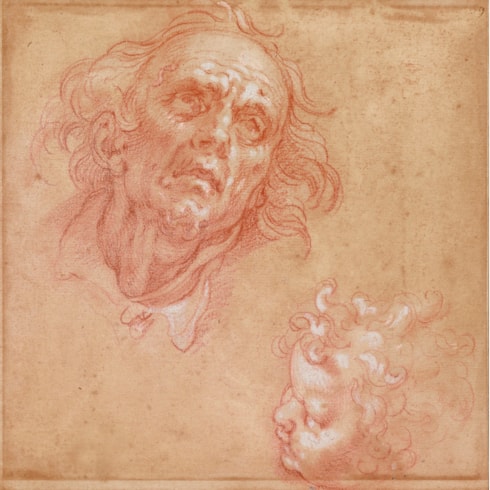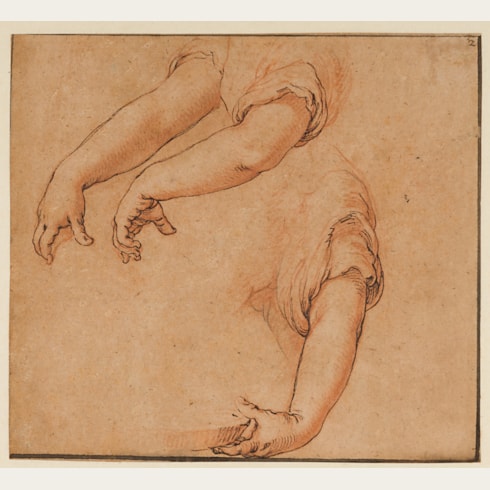Abraham BLOEMAERT
(Gorinchem 1564 - Utrecht 1651)
Drapery Study of a Seated Figure
Sold
Red chalk and black chalk, heightened with white, on buff paper, with framing lines in brown ink.
A sketch of an arm in black chalk on the verso.
Inscribed Abraham Bloemaert, in a modern hand, on the verso.
121 x 186 mm. (4 3/4 x 7 3/8 in.)
This drapery study is closely related to a drawing of a Seated Woman of c.1600-1605 in the Nationalmuseum in Stockholm. The drapery in both drawings is nearly identical, with only minor differences, and the present sheet may have been drawn from a posed model and later served as the basis for the more fully developed drawing in Stockholm.
Abraham Bloemaert received his artistic training in Utrecht and Paris but, unlike many of his contemporaries, never travelled to Italy. Indeed, apart from two years in Amsterdam in the early 1590s, he worked in Utrecht from 1583 until his death, at the end of one of the longest careers of any Dutch artist of his era. Almost nothing is known of his work before 1590, however, and it is only after his brief stay in Amsterdam that he began to establish a reputation as an artist of note. Together with Cornelis van Haarlem and Joachim Wtewael, Bloemaert came to be one of the last major exponents of the Northern Mannerist tradition. Among his most important religious works are the altarpieces of God with Christ and the Virgin of 1615 in the Sint Janskerk in ’s-Hertogenbosch and an Adoration of the Magi painted in 1624 for the Jesuit church in Brussels and now in Grenoble. Bloemaert enjoyed a very long and productive career of some sixty years, resulting in an oeuvre of around two hundred extant paintings, including landscapes, religious scenes, history subjects and genre scenes. He was a founding member of the painter’s guild of Saint Luke in Utrecht in 1611, and established a drawing school in Utrecht not long afterwards. As a teacher, Bloemaert’s influence was considerable, with artists such as Jan Both, Cornelis van Poelenburgh, Gerrit van Honthorst, Hendrick Terbrugghen and Jan Baptist Weenix all spending time in his studio.
Bloemaert was a gifted and prolific draughtsman, praised as such by his biographer Karel van Mander, who noted that the artist ‘has a clever way of drawing with a pen, and, by adding small amounts of watercolour, he produces unusual effects’. He produced numerous studies for paintings and engravings - some six hundred prints after his designs are known - as well as several landscape drawings and many sheets of studies of heads, hands and arms. Some of the latter were reproduced as engravings by his son Frederik and published in the 1650s as the Konstryk Tekenboek, a sort of model-book for students. The Tekenboek proved very popular and was reprinted several times, serving to perpetuate Bloemaert’s influence on later generations of artists. (Indeed, the 18th century French artist François Boucher published a series of etchings after Bloemaert’s figure studies, known as the Livre d’etude d’après les desseins originaux de Blomart, which appeared in Paris in 1735.) The bulk of Bloemaert’s enormous corpus of drawings, numbering around 1,700 sheets, appear to have been retained by his descendants for over fifty years, and it is not until the first half of the 18th century that they began to be sold and dispersed.
Provenance
D(irk?) Harting, Heemstede (according to a note in the van Regteren Altena collection files)
Iohan Quirijn van Regteren Altena, Amsterdam (his posthumous sale stamp [Lugt 4617] stamped on the verso), until 1980
By descent to his wife, Augusta Louisa Wilhelmina van Regteren Altena, née van Royen, Amsterdam, until 2006
Thence by family descent until 2015
The I. Q. van Regteren Altena sale, Amsterdam, Christie’s, 13 May 2015, lot 123 Private collection.
Literature
Jaap Bolten, ‘The Drawings of Abraham Bloemaert: A Supplement’, Master Drawings, Winter 2017, p.89, no.A50* and A29*, fig.278 (as location unknown), where dated c.1600.









